#Chinese Couple Figurines
Explore tagged Tumblr posts
Text

#Murano Glass Signed#Formia Vetri Di Glass#Venetian Art Glass#Chinese Couple Sculptures#Chinese Couple Figurines#Asian Home Decor#Oriental Home Decor
4 notes
·
View notes
Text
April 11-14, Xi'an, China:
Some pictures of the cultural landmarks of Xi'an and some miscellaneous pics to wrap up the posts about my Xi'an trip:
First is the Bell Tower/钟楼 and Drum Tower/鼓楼 of Xi'an. The Bell Tower and the Drum Tower of Xi'an were built in 1384 and 1380 respectively, during the reign of Emperor Taizu of Ming (personal name Zhu Yuanzhang, aka that one emperor who was a beggar). Both towers were rebuilt during Qing dynasty, then repaired extensively in the latter half of 20th century.
This square-ish tower is the Bell Tower:
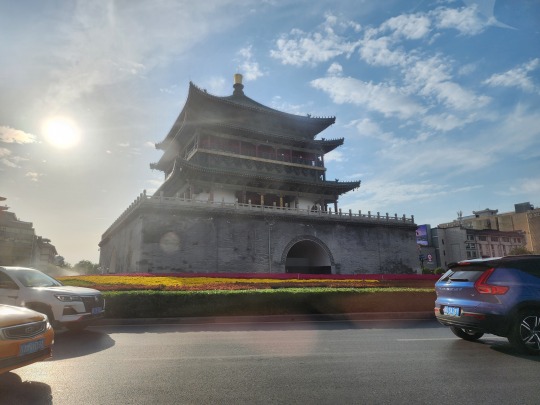
The hotel we stayed at was fairly close to the Bell Tower so I was able to get a couple more pictures of it, but we didn't go inside either towers though. I kind of regret that, but I regret not being able to go to the Shaanxi History Museum more.


Side note: the Tang-era Jingyun Bell/景云钟 used to be inside this tower (hence the name), where it would sound in the mornings to signal the beginning of the day. However, the Jingyun Bell was moved to Beilin Museum in 1953 for conservation purposes, which was also where I saw the real thing (see my earlier post about Beilin Museum), but a tour guide told me it would be moved again soon to another (indoor) museum, where it would stay for the foreseeable future. The bell that is inside the Bell Tower right now is a modern working replica of the Jingyun Bell.

And now the rectangular Drum Tower. The drums in the tower used to sound in the evenings, signaling the end of the day. This is summed up in the term 晨钟暮鼓, or "morning bell tolls and evening drum beats".

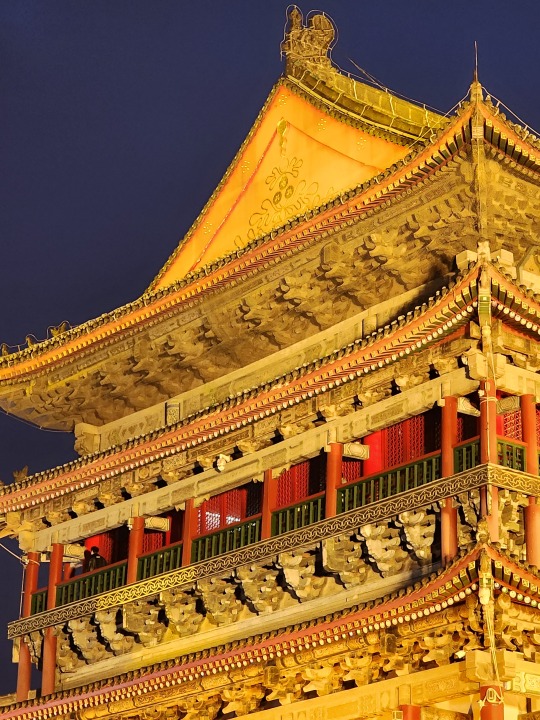
The bian'e/匾额 sign on the south side of the Drum Tower reads 文武盛地 (traditionally Chinese reads from right to left when written horizontally), which translates to "the place where literary and martial arts flourish". The bian'e itself is 8m (~26.2 ft) long and weighs 2-3 metric tons (about as heavy as a SUV). The bian'e on the north side of the Drum Tower reads 声闻于天, which translates to "a sound heard even in the heavens", referring to the sound of the drums. The phrase itself came from the poem "A Crane Cries" (鹤鸣; translation may vary depending on the translator) from the Classic of Poetry/《诗经》.

On to notable souvenirs from random shops:
Tang-era style Thicc Beefcake Horses 👌

Left: figurines of (mostly) Tang-era girls. Right: a type of candy from Sichuan called "dogshit candy"/狗屎糖 (yes that's really the name lol) made from soy beans, peanuts, and barley malt syrup (called maiyatang/麦芽糖). The smaller text on the bottom of the bag reads "eat dogshit candy and you will have dogshit luck", which actually means good luck btw, because the chances of stepping on dog doo-doo is actually kinda low if you think about it


And last but not least, the ancient city walls of Xi'an. The city walls that we see here were built at the beginning of Ming dynasty (latter half of 14th century), but analysis of the cross section revealed that it also contained sections of the Tang-era (618 - 907), Song-era (960 - 1279), and Yuan-era (1206 - 1368) city walls within it in layers. These walls are 12m (39.4ft) tall and the top of the wall is 12-14m (39.4-46ft) wide, enough to pass multiple horse-drawn carts at once, which was important for the defense of the city. Below is the Anyuan Gate/安远门 (the north gate), and this used to be where the Tang-era Taiji Palace/太极宫 (not to be confused with Taiji Hall of the Forbidden City) wall connected with the Eastern Palace/东宫, where the crown prince resided:
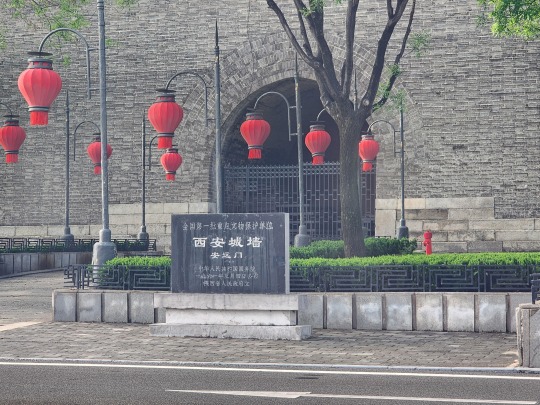
Coming around the side gate of Anyuan Gate. There's also a moat (护城河 in Chinese, lit. "protect city river"), but I didn't take pictures of it.

Outside the Shangwu Gate/尚武门. 尚武 roughly translates to "respect of the martial". There used to be draw bridges outside these gates as well, but for ease of modern transportation, most of them have been rebuilt as fixed bridges with roads on top for vehicles and pedestrians. The only draw bridge that has been rebuilt (that I know of) was the one outside the Yongning Gate/永宁门 aka the southern gate.

Leaving Xi'an city. These are the corner towers of the city wall:


Two cute sculptures inside the Xi'an Xianyang International Airport/西安咸阳国际机场, the left one represents Shaanxi's Qinqiang/秦腔 folk opera, and the right one is, of course, the famous terra cotta soldier:

Goodbye Xi'an! Hopefully I can come back in the future and go to Shaanxi History Museum..........

#2024 china#xi'an#china#bell tower#drum tower#xi'an city walls#chinese architecture#chinese history#chinese culture#architecture#history#culture
65 notes
·
View notes
Text
My head cannons for the Shaw pack listeners!! ( most listeners will be referred to with gendered prns that aligns with the gender I see them as )
Starting w/ . . .
ANGEL!!
My angel is Blasian ( African American on his mothers side and Chinese on their fathers )
His birth name is Niviyah Anderson and didn’t change his name at all or consider his birth name his dead name, just tells people to call him Vi now
He’s Transgender specifically trans-masculine
He’s been on T for 2 years and has grown immensely because of it, he used to be average 5’7 but now he’s 6’2
He has a more Dark Academia Style and loves a good turtleneck
One of the more stylish out of all the mates in my opinion just doesn’t dress up unless it’s actually important
Dyes his hair a lot, his current color is closer to his actual hair color ( he’s a ginger but he has a blonde streak in his hair )
Speaking of hair his hair is medium length, I like to think he buzzed it once to see if he could rock a fade and decide against it
Has the weirdest curly hair care routine but somehow it works and keeps his hair soft ( when he tried to explain it to Milo he almost lost his mind )
Also still on the topic of Hair, Angels hair type is 4a not the loosest curl but not to tightest of a curl and most of the time very frizzy
My angel is extremely neurodivergent I believe they have Adhd, Autism, and OCD
They do a lot of rigid tasks with a lot of very specific steps to achieve a sense of balance to stop themselves from feeling distressed or extremely anxious
The first couple of times they went to a pack meeting they had to sit in the car until it started because of how chaotic it was in the beginning
He definitely has a very specific way he plays Minecraft and other free roam games to keep order
They have a huge collection of Beads and are constantly making bracelets for people they care about
Loves making and trading Kandi
This is just how I think they have the other mates and wolves in their phone (David = Davey Waveyyyy 🐺 ) ( Asher = Puffball ) ( Milo = Aggros Father 🐈⬛ ) ( Darlin = Strawberry icecream 🍨) — Mates : ( babee = Big Boss! ) ( Sweetheart = Sneaks ) ( Sam = Grampire )
BABEEEE!!
My babe is Mixed! African American and Mexican
Their name is Tahlil Karlos Garcia
I see babe as a Cutecore enthusiast, before them and Asher got their own place a majority of their decor was an extremely light pink
Same with their clothes if not pink than pastel versions of different colors but overall very cute!!
They’re closer to an average height of 5’8
They’re Non-Binary and Bi-sexual!
Has never dyed their hair in their lifetime, it shocks literally everyone in the pack that they haven’t cause most people in the pack have!
Is always dress up someway in Cutecore, they love cutesy pajamas and it’s great cause Asher loves to match
Their hair is extremely short and curly, it’s also a very dark Brown!!
They love animated tv shows and movies, their favorites are She-Ra, My little pony, and TD Island
They prefer Fighter games like mortal Kombat over regular soft games. But they do really love animal crossing
They sew clothes all the time, when the pack kids are having issues with clothing whether it be a hole that needs to be patched or a resizing they’re the one they go to
Angel and Babe trade Kandi constantly
My babe has ADHD and extreme social anxiety! They may seem well put together at least in relation to Asher but the more you get to know them the more chaotic you see that they are
Extremely quiet, most people in the pack including David thought they were mute for a long time
They are however fluent in sign language and do use it a lot because of how little they talk (only David and Darlin can actually understand them)
They have an extremely loose curly I’m talking like 2c-3a
Loves collecting Miku Figurines!! And basically anything they can get their hands on
In order of most loved its Miku Figurines, Hirono blindboxes, Peach Riot blindboxes, mofusandd, labubu, and then fugglers
SWEETHEART!
Also Blasian in my eyes except My sweetheart is Panamanian and Japanese
Her Father is African American and Panamanian and her mother is Japanese
My sweetheart is Cisgender woman and pansexual
My sweetheart is 6’5
My sweethearts name is Makaila Gonzalez Tokugawa
Sweetheart wears their hair in locs!! I like to think they loc’ed up a little bit after that has gotten with Milo and things were getting serious. Now they’re loc’ed and in love :D
Sweethearts hair before locs was always in some sort of short protective style like mini twists or a braided bob with curly ends because her hair is 4c. But after she loc’ed up she took to the loc bob and other styles that keep her hair out her face.
She does in fact dress like a detective from the 1960’s for work, outside of work she’s normally in very comfortable clothing and 9/10 depending on the night before her day off it’s not hers
I’d say the most energetic out of the mates especially when it’s just a hang out with the guys and their mates. Loves hanging out with all of them
Doesn’t play many video games because of work but does really love The Callisto Protocol and Super Smash Bros. She also really likes to play Dark Deception
Is fluent in 5 languages ( English, Spanish, Japanese, French, and Korean )
Besides cases that her bosses put her onto she works with troubled kids that end up in department custody for extended periods of time
Enjoys Sci-Fi heavy books more than any other genre
Extremely organized and proud of that organization. She has a whole system when it comes to organizing cases she’s actively involved in. Each case depending on it’s severity, importance, and current activity gets a color, number, and symbol attached to it and is filed away accordingly
My sweetheart is Autistic and Daydreams a lot to cope with her surroundings.
My sweetheart collects physical media, specifically books and cds. She also collects makeup products but considers it a guilty pleasure because she thinks it’s out of the ordinary to collect makeup
Likes putting aggro in cute little sweaters made by Babee
Darlin!!
My Darlin is Afro-Latino, his father is Panamanian and her mother is African American.
Darlin is Agender and Arospec
They were born in the Deep South on a poorly managed ranch with their dad.
They moved to Washington at the age of 2 originally to stay with their older cousins while their dad put in the work to get their home and lively hood back into shape.
It overall didn’t work out and Darlins dad moved up with them to Washington to get a job that would last them a while
Darlin was given to Marie at the age of 4 because their father couldn’t take care of them
They have a very large collection of Butterfly Knives
My Darlins name is Augustine Diaz, though Asher calls them Auggie it’s a nickname that sticks all throughout their teen years in the pack
Darlins Hair pattern is closer to straight than anything but it’s because of routine heat damage. They used to have very thick defined curls and are trying to get back to that slowly
Darlin is a blonde
My Darlin is extremely short 5’5
Their clothing style is a hoodie and sweatpants but they have been wearing and experimenting with style the longer they stick with the pack ( Milo forced them to go shopping for more clothes )
My darlin has adhd, autism, and npd. I also head canon them to be a system specifically did
The least energetic out of the listeners but definitely the most chaotic in their own way
Very good friends with Christian
Has a love hate relationship with Sweetheart and her scary game addiction
My darlin isn’t a wolf shifter instead they’re a Dhole shifter
Very affectionate while shifted loves getting rubs and giving cuddles
Likes Sonic and uncontrollable amount, has been collecting sonic themed things for literal years
Has a bunny for a pet, his name is Manny it’s short for Emanuel. Asher and Milo call him Man Man
Extremely sleepy all the time, takes naps literally every where to the point it’s concerning
Marie has so many baby photos of darlin in her photo album and uses it to keep darlin in line
#redacted#redacted asmr#redacted angel#redacted david#redacted darlin#redacted sam#redacted sweetheart#redacted milo#redacted asher#redacted babe#redacted aggro
21 notes
·
View notes
Text
Eternal sunshine of the spotless mind AU where Suguru erases Satoru from his memory and then Satoru does the same out of spite
But unlike in the movie they’re not meeting each other for the next ten years after that. Till one day someone leaks the files that were kept in the archive by the company that provides the service.

It’s been ten years already. Satoru touches an old ink on paper that forms a date like it's supposed to make everything feel more real. These memories are older than some of his students. He barely even remembers what kind of a person he was back then. All that’s left from his early twenties is a faint feeling of absence — as if he was missing a place that never existed.
Turns out it was a person.
«Do I just tell you everything I think about?» his own voice on the tape asks. «Anything? That’ll help to perform the procedure, right?»
He doesn’t remember this conversation.
He doesn't remember going to that clinic at all.
He goes through the tapes listening to himself — funnily familiar, — his words are almost petty sometimes.
«Suguru never wants to watch the movies I want,» the voice on the tape says. «He complains that I’m being repetitive. I’ve been watching a lot of new stuff lately, you know. I’ve watched ten new movies for the pas…»
His finger skips to another timestamp marked on the list.
«A Chinese restaurant».
«I asked him out that day. I wanted to go to that new Chinese place because I wanted us to feel like a couple again,» the voice says. «It's been a while since we went out together. Yeah, I've been busy, but he’s always in the wrong mood when it comes to anything I suggest. How is that my fault now?»
Does it still matter? That Chinese place he was talking about was closed eight years ago — redesigned to be a convenience store or something like that — now it probably belongs to some retail chain with all doors indistinguishable from one another. He’s moved two times since then.
And another one.
«He’s always sulky, you see. Even after sex lately. I can picture that… Ugh, I can picture that face he does. Right now, I can do it. And he always says he’s fine like I'm supposed to guess what might make him happy. And I never can. Can you get it erased first so that I don’t have to think about it anytime I close my eyes? Can you do it first?»
«This procedure is done in one go,» the doctor answers. «No particular order. Please, continue».
He does.
«He said I can’t change and he doesn’t want to force me. Well, I’m sorry I don’t like to let go of the things that I love. Is that worse than not being able to commit to anything even when it’s hard?»
«I hope he’d be happy if he knew I'm doing this. That's certainly a change, right?»
And another one.
«He never tells me anything», the voice on the tape says. «Not even when I ask. It’s like I know something’s not right but I can’t get an answer out of him. Or I can't formulate the right question, he'd like to answer. It fries my brain.»
«The other day he said we don’t see eye to eye anymore. Why can’t he just talk to me? Why couldn’t he talk to me till it was too late?»
And another.
«Is he punishing me for something I can’t understand?»
The room falls silent. Dead — haunted by the memories. Do they still belong to him or have they turned into ghosts by now? Separate beings with their own mind and will.
He caresses a postcard from Okinawa — unfamiliar handwriting and a ripped edge, he almost feels a salty wind on his tongue, — an old monster figurine, a plain white t-shirt that belonged to Suguru. And the pictures.
They’re so happy in all of them. But the voice on the tape keeps repeating.
«He got me eased. He got me fucking erased. He got me erased.»
Why the fuck did he do that?
Mad at the person he doesn’t even know. Like it’s the only thing that matters in the world right now. Like nothing's happened after that in his life. No new apartments, no new jobs, no new vacations, no new boyfriends.
He’s been through a few relationships in the past ten years but none hurt enough to even consider anything like that.
Because he never loved them.
Because he still loved someone else.
At least now he knows why his life felt empty when he woke up alone in that crammed apartment that somehow felt too big. And why it felt so lonely ever since.
He goes through the files — none of the records contain an address or a phone number. Or an answer to the question on his mind.
What if Suguru is happy with the procedure? What if the words — falling out of his own mouth out of spite — were true.
A call wakes him up on a Saturday morning.
«Hello, Satoru-u,» there’s a smile in that man’s voice he can hear. «I mean… Sorry if it’s too… Sorry. I don’t know if you’re a morning person or a night person.»
He gulps.
That’s him that’s him that is
thatisSuguruthatisSuguruthatisSuguruSuguru from the postcards who bought him figurines as a gift
Suguru who didn’t want to go to a place that doesn’t exist anymore
Suguru who didn’t want to tell him anything
who thought he can’t change or adjust to the changes — yet they’re both still caught
shit
SuguruSuguruSuguruSuguruSuguruSuguruSuguruSuguruSuguruSuguruSuguruSuguruSuguruSuguru
it's him
«Uh, I got…» he coughs. «I went to bed late last night.»
«Did you get the files?»
«Yes, I…» he laughs. «We were a shitty couple, weren’t we?»
And then Suguru laughs too.
A laughs that feels like a first sound of thunder after the drought — like those memories are dried flowers everyone thought were dead till the rain came.
«You’re with anyone right now?» Suguru asks.
«No,» answer’s too fast but he takes a pause before he says: «What about you?»
«No, not really. It’s not serious I guess.»
Satoru smirks.
«Not enough to get them erased from your memory, right?»
A joke doesn’t land as well as he expected. For a moment he almost believes Suguru’s going to hang up on him.
But still he continues.
«I don’t know…» he says. «I don’t know if I should apologise for something I can’t remember but I feel really sorry.»
«I don’t know if I can forgive something I can’t remember.»
Another pause.
Should he — if there’s nothing that holds these memories anymore. It’s like someone dug out a time capsule you hid under an oak tree when you were a child. All those names and events in your notes that were so important. Yet you don’t even remember half of the names.
It still hurts though.
«Yeah, I guess,» Suguru sighs. «I think there’s a bright side to it. We’re older now so we won’t repeat the same mistakes.»
«You think?»
«That's how it's supposed to be when you're getting mature.»
«Hm-m,» Satoru smiles. «I don't know about that actually. We're more experienced now. So we can always use that knowledge to make things worse.»
Sharing another laugh that’s warmer and more familiar like his brain is riddled with the scars that started itching all at once.
They used to laugh a lot, it strikes him.
They used to tease each other, they used to kiss and make love. He used to remember that person’s voice and face better than his own.
Why did he let go of that?
Why didn’t he let it heal and warm him? Because somehow he still knows that guy — he knows what'll make him laugh and he's sure they even talk similarly sometimes, using the same words and phrases.
Why did he let it go?
«Wanna meet?» Suguru asks.
«Do you?»
«Yeah. At least we’ll find out if we're the biggest idiots in the whole world or not.»
«I know I am,» Satoru nods as if they're in the same room and all of a sudden he realises that he doesn't want this conversation to end. «Besides, I think the company’s going to get sued after the incident. There're plenty of other idiots who would want some compensation from them. Which means we’re not getting another chance to chop our brains again. Do you think we can get some money though? I could use a new car. Or a fridge. Probably a vacuum cleaner would do. That's the mature stuff, right?»
A laugh that could belong to a couple of teens — head over heels in love — something he thought he never experienced.
Turns out he did.
And there’s still time.
#jjk#jujutsu kaisen#jjk au#satosugu#gojo satoru#geto suguru#goge#i post jjk au of the day till i run out of ideas or give up or forget
28 notes
·
View notes
Text
Imagined East and Authentic Poetics: The Echo of CHUCUI PALACE in Chinoiserie
In 18th-century France, artists turned their gaze toward the distant East, attempting to construct an idealized imaginative realm beyond reality. Chinoiserie — literally “Chinese style” — emerged accordingly. It was not an accurate replication of Chinese culture, but rather a reconstitution imbued with fantasy, poetic sensibility, and aesthetic delight, reflecting the Western world’s romantic imagination and philosophical projection onto Eastern imagery.
Within royal palaces and aristocratic mansions in France, Chinoiserie manifested through murals, porcelain, furniture, and more. Common motifs included elegant ladies, cranes, birds and flowers, gardens, and pavilions. These images wove together truth and fiction, portraying the East as a utopian realm beyond reality — where all beings possessed spirit, nature followed order, and humans lived in harmony with their surroundings. Chinoiserie was not merely a decorative style, but a reflection of an aesthetic worldview: it blended with the Rococo spirit of lightness and fluidity, pursued sensuous freedom, yet retained a deep dedication to order and refinement.
Today, the global cultural context has quietly shifted. The East is no longer simply the object of gaze but has become a subject of dialogue. In this new landscape, artists are responding anew to the aesthetic frameworks of Chinoiserie, transforming the once-imagined East into a self-assertive East, creating an aesthetic echo across time and culture.

Marriage A-la-Mode: 2, The Tête à Tête, by William Hogarth
Take Marriage A-la-Mode: 2, The Tête à Tête as an example — a satirical series by 18th-century English painter William Hogarth. Viewed through the lens of Chinoiserie aesthetics, this work not only reflects 18th-century British society’s fantastical perception of the East but also weaves Chinese elements into its critique of moral decadence via symbolic means. On the mantlepiece sits a set of Chinese porcelain — tall-necked vases, figurines, and symmetrically placed small jars — constituting a typical Chinoiserie visual lexicon. In 18th-century Britain, such items symbolized status and wealth, with their exotic provenance contributing to a sense of “foreign luxury.” Hogarth deliberately places them above the hearth, alongside a broken Roman bust, suggesting a collapse in cultural order — Western rationality (the classical ideal) is shown as being eroded by Eastern indulgence (Chinoiserie).
The couple depicted lives in luxurious yet empty surroundings, implying the hollowing out of marriage and aristocratic values. Chinese porcelain here is no longer a poetic symbol of a mysterious East but a vessel for exotic desire. This reflects the prevalent orientalist perspective of the time — China was reduced to a visual commodity, framed as the irrational and undisciplined “other,” thereby accentuating the West’s anxiety and performative pride in order and civilization.

CHUCUI PALACE’s “Kirin in Clouds” Brooch
Turning to the jewelry aesthetics of Chinoiserie, the “Kirin in Clouds” brooch by CHUCUI PALACE exemplifies a contemporary echo of the genre. Inspired by the mythic image of a qilin soaring through clouds, the design fuses Eastern symbolism, Chinese meticulous painting, botanical gem art, Western ornamentalism, and classic European setting techniques to achieve an aura of noble elegance.
The brooch is encircled by swirling cloud patterns, evoking both flowing currents and lingering mist. This treatment reflects an astute synthesis of Western baroque emphasis on rhythm and ornamentation with the expressive abstraction of Eastern brushwork, reinterpreting the cloud motif as both movement and spirit — a visual flow that also condenses aesthetic breath.
The qilin’s scales are arranged in pink, blue, and gold — not as simple color overlays, but as a harmonious balance between restraint and richness. The gentle gradation of hues resembles the breathing of light and shadow in Chinese gongbi painting. Its mane and limbs are sculpted with ribbon-like elegance, tracing the mythical creature’s poised dynamism. The craft here transcends mimicry, awakening a spiritual sensibility that evokes reverence in the viewer.
The cloud forms are rendered in openwork, enhancing transparency and lift. The qilin’s cloud-riding stance is not just symbolic but structurally extended through design logic. Lotus blossoms dot the creature’s form — not mere adornment but symbolic of spiritual purity in Chinese culture. The petals, shaped through traditional Chinese carving, unfold in quiet layers like a glow blooming in silence, lending the piece a living, temporal rhythm.
Notably, the brooch also absorbs the Western decorative tradition’s emphasis on rhythm and visual tension. Its overall composition aligns with 18th–19th century European preferences for dynamic curves and intricate detailing. The swirling cloud lines beside the qilin recall baroque scrollwork, directing the eye with layered movement. Structurally, the piece embodies precise proportional control — a hallmark of Western aesthetic logic — where every gesture and contour seeks a unity of form and rhythm. This work, while rooted in Eastern imagery, resonates deeply with Western traditions of form and order, achieving a profound cross-cultural aesthetic synthesis.

Chinoiserie Snuffbox, circa 1750, V&A Museum
Another example is the Chinoiserie snuffbox from around 1750. The pierced gold ornamentation on the lid, though not a realistic depiction of China, presents an imagined Eastern landscape typical of French and British Chinoiserie at the time: pine trees rise, figures sit within pavilions, and the background suggests winding rivers and mountains. The base is enameled in deep blue, creating a night-sky depth that contrasts with the golden openwork, amplifying the decorative drama. This goldsmith technique not only showcases the 18th-century European mastery of detail but also aligns with Chinoiserie’s Western affinity for lightness, complexity, and fluid form.
Notably, palmette motifs from neoclassicism frame the box — distinctly Greco-Roman elements that contrast with the Eastern theme. This juxtaposition of heterogenous styles reflects the transitional aesthetics of the mid-18th century, as Rococo declined and Neoclassicism emerged. Decorative arts of the time sought to coexist diverse cultural idioms within a single object, crafting a polyphonic visual language.
Chinoiserie — from its fantastical construction in 18th-century European courts to its reinterpretation in modern artistic language — was never a mere surface depiction or image appropriation of the East. It was a multi-layered cultural mirror: projecting Western desires, poetics, and imaginations of the “other,” while also refracting internal tensions about order, freedom, luxury, and morality. Within this mirrored relationship, the East was stylized and symbolized, yet through such processes, dialogue and exchange between Eastern and Western aesthetics began to emerge.
Whether it be Hogarth’s ironic insertion of the “decadent East,” CHUCUI PALACE’s poetic qilin imagery, or the snuffbox’s mingling of baroque and neoclassical motifs, Chinoiserie is not merely the product of aesthetic taste — it is a narrative field in visual culture where questions of identity, power, and temporality unfold. In today’s increasingly entangled cultural landscape, revisiting Chinoiserie is more than a nostalgic gaze — it becomes a critical act of re-understanding how culture is imagined, represented, and continually redefined through tension and fusion.
0 notes
Text
Chinese tea ceremony
China's culture surrounding tea emerged in the Tang dynasty and was influenced by it's neighbouring east Asian countries ,Japan and Korea, however each country has developed it's own form of the tea ceremony. Tea ceremonies are part of Chinese wedding traditions in which the couple honour there parents and grandparents by serving them tea.

Tea pets:
This is a small pottery figurine is kept as a ornament or a good luck charm and it's usually place on the tea tray. Tea is pored over the pet as a sort of offering which gives the tea drinker good luck.
youtube

0 notes
Text
Best Restaurants in Lonavala for Lunch Pali Village Lonavala
Best Restaurants in Lonavala is a beloved hill station that offers an escape from city life, filled with serene views and misty weather, and a thriving culinary scene. For those looking to enjoy a memorable meal in a charming village setting, Pali Village in Lonavala is an ideal destination. This area has some of the best restaurants in Lonavala, where local flavors and diverse cuisines blend to offer unique dining experiences. Here’s a look at some of the top restaurants in Pali Village, each one worthy of a visit.
Best Restaurant in Lonavala, Pali Village in Lonavala is home to some of the best restaurants that bring the charm of rustic village life together with culinary delights, making it a favorite destination for food lovers, especially couples and families. Known for its scenic surroundings and tranquil atmosphere, this area offers a unique dining experience, blending serene ambiance with delicious food that makes for an unforgettable meal.
Best Restaurants in Lonavala For Couples, Pali Village in Lonavala is a top destination for couples seeking a serene, intimate dining experience with a mix of natural beauty and culinary excellence. Nestled amidst the lush, scenic backdrop of Lonavala, Pali Village offers an escape from the city’s hustle and bustle, providing couples with a perfect setting for romantic dining. The village ambiance itself is known for its tranquil atmosphere, and the nearby restaurants enhance this vibe, creating a haven where couples can enjoy a blend of quality cuisine, service, and unique settings. Here’s an overview of some of the best restaurants in Pali Village, Lonavala, where couples can experience memorable dining moments together.
Best Best Restaurants in Lonavala For Family, with its lush landscapes, serene hills, and misty weather, is not just a top destination for a quick weekend getaway; it’s also home to some of Maharashtra’s best dining experiences. Among these culinary treasures, the restaurants in Pali Village offer a wonderful mix of both modern and traditional cuisines, perfect for family gatherings. These restaurants stand out for their scenic views, comfortable ambiance, and menus that cater to varied tastes. Here’s a look at some of the best family-friendly dining options in Pali Village, Lonavala.
1. The Kinara Village Dhaba Kinara Village Dhaba is a popular choice among families visiting Lonavala. It blends traditional Indian decor with rustic vibes, complete with outdoor seating that captures the essence of a village dhaba. With a range of North Indian, Mughlai, and even Chinese dishes, it provides something for every family member. Kids will enjoy the open space, animal figurines, and even occasional live music, while parents can relax and enjoy authentic flavors and freshly prepared dishes.
2. PNF Restaurant & Bar PNF Restaurant & Bar is well-known for its cozy, warm interiors and a scenic outdoor seating area, which is ideal for family lunches or dinners. The restaurant has an impressive selection of North Indian and Chinese cuisine, which is prepared with fresh local ingredients. It’s a great spot for those who appreciate a quieter, more intimate setting. The menu is extensive, offering everything from flavorful biryanis to rich curries, making it ideal for family members of all ages.
3. Sheetal Da Dhaba For families looking for a more authentic Punjabi dining experience, Sheetal Da Dhaba is an ideal spot. It has a spacious seating arrangement, including an open-air dining area with comfortable charpai (cots) seating, perfect for a relaxed family meal. Their signature dishes include tandoori delights, buttery dals, and a variety of breads that capture the rich flavors of Punjab. They are especially famous for their mouthwatering kebabs and hearty curries, which are a treat for both kids and adults alike.
4. Lagoona Resort Restaurant Located within the Lagoona Resort, this restaurant offers an elegant dining experience paired with beautiful lake views. It’s an ideal choice for families who want to dine in a peaceful, scenic environment. The menu offers a mix of Indian, Chinese, and Continental dishes, appealing to a range of tastes. Lagoona’s serene ambiance and family-friendly setup make it a perfect choice for special celebrations or a relaxing lunch during a family trip.
5. TRIO Resort and Restaurant TRIO is another notable option in Pali Village, popular for its varied cuisine and inviting ambiance. This restaurant has indoor as well as outdoor seating options, providing views of Lonavala’s beautiful surroundings. It’s known for serving up a mix of North Indian, Chinese, and Continental dishes. For families with children, the place offers ample space to move around and explore, adding to the appeal.
6. Café 24 by Della Resorts For a luxurious dining experience, Café 24 at Della Resorts is a standout choice. Located amidst the lush surroundings of Della Adventure Park, the restaurant provides an upscale ambiance and exceptional service. Its multi-cuisine menu includes everything from North Indian and Chinese dishes to European delights, perfect for satisfying varied tastes within a family. This restaurant’s charm lies in its beautiful, modern interiors and poolside seating, which offer a relaxing and upscale dining atmosphere.
When dining with family in Lonavala, these Pali Village restaurants offer a diverse range of experiences—from rustic dhabas with traditional flavors to more refined, elegant settings. With scenic views, family-friendly ambiance, and delicious food, each of these eateries adds to the memorable experience of a Lonavala trip, making family time special and satisfying.
0 notes
Text
0 notes
Text
Why Should You Have a Family Dentist?
All families should have their trusted dentists in Lansdowne. Family dentists in Lansdowne are crucial to ensure that all your dental needs are taken care of. Going to a single clinic offers convenience especially if you need to schedule appointments for yourself and your children. Since dentists in Lansdowne have your family dental record, your visits will be more efficient. You can also avail of different services like preventive dentistry and dental education to ensure that your oral health is at its best. There are also some clinics that offer discounts if you get a group package. Lastly, going to the same dentists in Lansdowne ensures continuity of care as they can track your progress if you have ongoing treatments or offer follow-up care as needed.
Riverside Dental Family & Cosmetic Dentistry
If you are looking for dentists in Lansdowne, you should go for clinics that offer a comprehensive service. This should include preventive, cosmetic, emergency, and restorative dentistry. This way, you do not have to move from one clinic to another. Riverside Dental Family & Cosmetic Dentistry is one of the trusted dentists in Lansdowne. They cater to patients of all ages and offer a wide variety of services including sleep apnea treatment. With a 5-star review, you can be assured that the dentists in Lansdowne will take care of all your dental care needs. Call them today and get the best care from topnotch dentists in Lansdowne.
youtube
Leesburg, VA
As the county seat of Loudoun County, Virginia, Leesburg is a suburb bedroom community. Its name comes from its early settlers, the Lee family. The town has experienced a considerable growth and development in the past three decades. Today, it is the home of different soccer teams like the Loudoun United FC and the Northern Virginia United FC. It is also interesting to know that the Federal Aviation Administration’s Washington Air Route Traffic Control Center is in town. It has several historical sites that are listed under the National Register of Historic Places making it a popular tourist destination. With its promising future and deeply rooted cultural heritage, Leesburg is one place that you must visit if you are in Virginia.
Marshall House
Marshall House or also known as the Dodona Manor is the former home of General George Catlett Marshall. Located along East Market Street, this house museum is an important landmark in the city and listed in the National Register of Historic Places. Evidence shows that the house was built in the early 1800’s. Today, it houses several memorabilia and furnishings owned by the Marshalls and their heirs. Some of the items include a 1950’s painting of Winston Churchill, Chinese figurines, and multiple portraits. There is also a garden just outside the Marshall House which is believed to be the original garden of the Marshall couple. Guided tours are available to anyone who wish to visit the museum.
New Speed Limit Signs, Transition Zones Added in Downtown Leesburg
In order to make the road safer for pedestrians and reduce the severity of crashes, downtown Leesburg has new speed limits. From a maximum of 25 miles per hour, drivers should limit their speed to only 20 miles. Speed limit signs are all over the area to remind motorists about the new policy. Remember that there are legal consequences if drivers fail to follow this. One may face tickets, license suspension, or even imprisonment in severe cases. If you do not want to experience all these inconveniences, it is best to follow the traffic rule and at the very least, set a good example to young people to follow. Adhering to the rules will not only free you from possible penalties but it will also help contribute to a culture of safe and responsible driving.
Link to maps
George C. Marshall's Dodona Manor 312 E Market St, Leesburg, VA 20176, United States Head southeast on E Market St toward Loudoun St 3.4 mi Take the exit toward VA-659 N/Belmont Ridge Rd 0.5 mi Keep left at the fork, follow signs for VA-659 N/Belmont Ridge Rd and merge onto VA-659 N/Belmont Ridge Rd 0.5 mi Turn right onto Riverside Pkwy 0.8 mi Turn right onto Sandridge Way 249 ft Turn left Destination will be on the left 200 ft Riverside Dental Family & Cosmetic Dentistry 19490 Sandridge Way #110, Leesburg, VA 20176, United States
0 notes
Photo

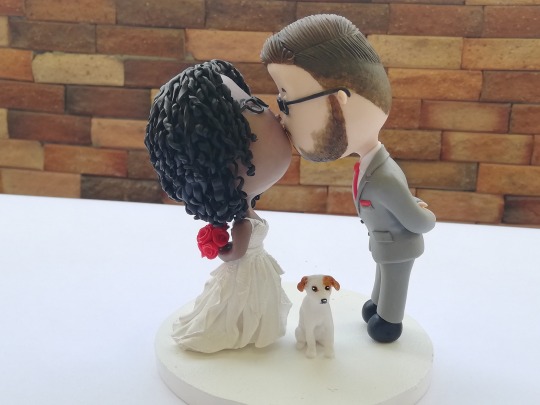

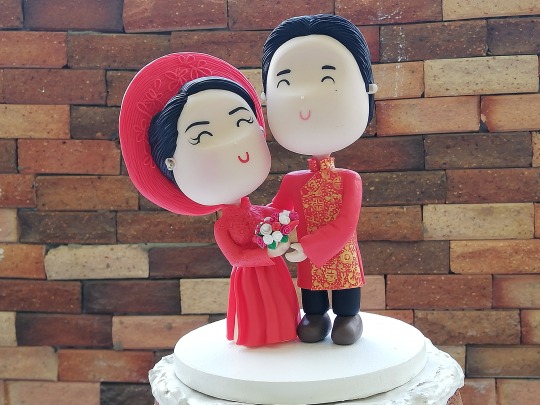



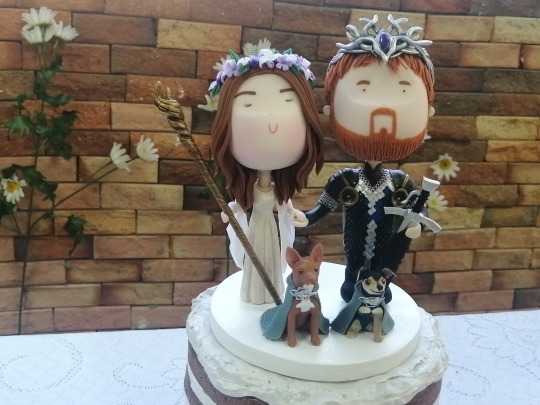
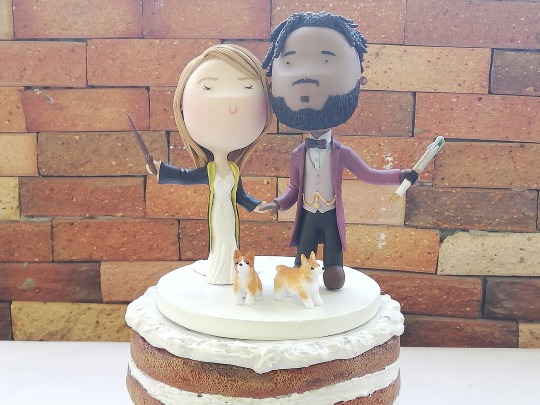
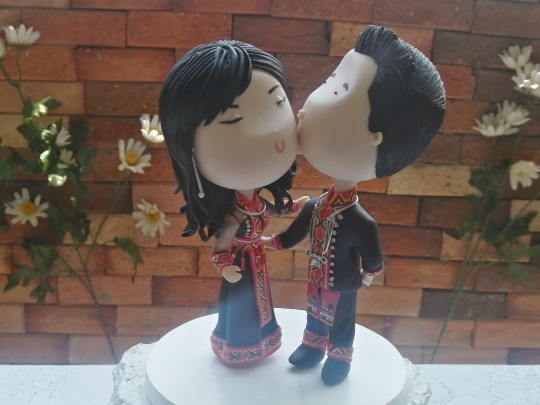
A bit of self promotion in my forgotten corner of the internet. My teammates and I are offering 25% off on all custom figurines for March 2021 and beyond. The sale will last till December 2th on our Etsy shop.
They are handmade to order, everything from their outfits, hairstyles, skin tones, hair color, accessories and pose can be customize to your liking. You can see a few examples of the hundreds we have made over the years.
We are also offering 30 to 40% off for orders needed late in 2021 (August and beyond). Just contact us directly at our email [email protected] or via PM in Etsy. This offer will last till the end of the year at least and maybe all of January.
We mostly specialize in making unique figurine keepsakes for weddings and anniversaries but have also made them for other events, they are all made to last forever (as long as you don’t drop them and break them or subject them to extreme weather) And although all the examples I place here have oversize heads (because it is our most popular style), we also make them with proportionate heads which you can see at our Etsy shop.
#non-sims#artificeproducciones#handmade figurines#cold porcelain clay#hecho a mano#masa flexible#lookslikeyou#romantic couple#themed wedding#harry potter#dr who#lort#esdla#hmong wedding#mexican wedding#chinese wedding#vietnamese wedding#star wars#lgtb wedding
3 notes
·
View notes
Note
hiii there!!! i've been focused on eastern fashion for some time now and so far i haven't come across good sources for studying anything from china, let alone east asia. so this probably has been asked before but what advice do you have for new people trying to study chinese fashion?
I do have a couple personal tips! This spiralled off into a very long post which also addresses some historiographical issues, read til the end if interested.
Primary sources
Good books and articles about Chinese fashion history are few and far in between, and may not cover every time period, so primary sources are your best friends. Try to find as many artworks and texts related to fashion as possible for the time period you’re interested in, and don’t feel limited to “famous” artworks or conventional genres. “Famous” historical Chinese paintings rarely depicted realistic fashion, if they depicted people at all. Fashion should be sought in formal portraits, book illustrations, photographs, export art, figurines and burial artifacts etc.. The availability of each genre depends on the time period, the further back in time you go the more scant sources become, which is why I would recommend newcomers begin with a more recent time period, like the 19th and 20th centuries. For fashion history purposes, all visual resources are valuable as long as they depict realistic fashion, and artworks from historically less prestigious genres can be very helpful for cross referencing.
Ideally, one should have a variety of sources across genres. For example, Republican era fashion is usually studied through calendar paintings (月份牌), but these only depicted upper class women in a very specific commercialized, socially conservative context. Therefore, it would be helpful to also look at professional fashion illustrations, photographs of film stars and costumes in films for avant garde designs, as well as photographs of common women for more everyday attire. For the 19th and 20th centuries, it’s good to have artworks as well as photographs/videos, to understand both the fashion ideal and how it transferred onto real bodies.

Avant garde evening fashion on actress Hu Die, early 1930s.
Most of these things could be found online, through both reliable and dodgy methods. Since I don’t live in China, I can’t visit any museums that physically hold the artifacts, so I just pray that they have things digitized. Fashion historians and enthusiasts on Weibo and Xiaohongshu also post sources they have pretty often, so do check out those platforms. I’m afraid I can’t regularly see what people there have to say because Chinese social media platforms stress me out and give me anxiety as a Chinese person.
It is also important to be able to parcel out what primary sources are reliable for fashion history purposes, whether they depict real life fashion or something fantastical. This is most relevant for Chinese fashion prior to the 19th century, as the abundance of artworks in the 仕女 shinv genre often led people to mistake the imaginary costumes they depicted for real life fashion, because they adhered to stereotypes of “ancient” Chinese clothing cultivated in the 20th century. Shinv as a genre that specifically portrayed women gradually stopped depicting actual women’s fashion in the Late Middle Ages, and developed an “industry standard” style of fantastical costuming based on a fossilized version of Tang and Song styles (not actual Tang and Song fashion). I don’t know why this is but I know it is. Shinv artworks should NEVER be used as fashion history resources, those created after the Song Dynasty should be viewed with suspicion. Faulty understandings of pre-Qing fashion in older literature mostly stem from the inability to distinguish shinv artworks from realistic ones. With some experience of looking at these paintings, it becomes very easy to tell them apart from formal portraits and illustrations that depict real fashion. Here are some established features of shinv costuming:
The top is always tucked inside the skirt, which is contrary to real life fashion in the Yuan, Ming, Qing and 20th century.
The hairstyles are very tall and complicated, often gravity-defying
There are long, dangling decorative tassels and braids hanging from the waistband, as well as other accessories that contribute to flowiness, such as 披帛 pibo shawls

Shinv piece by Xu Beihong (1895-1953). The style of costuming is consistent with shinv artworks from previous centuries; obviously real life women did not dress like this in the early 20th century.
Use recent literature
This is a general academia thing not just fashion history, but for some reason people tend to make an exception when it comes to Chinese fashion history. DO NOT RELY ON BOOKS THAT ARE TOO OLD, especially if they’re written before the 2000s. There were a series of books on Chinese historical fashion from the 70s and 80s that were highly influential foundational works for the subject, but with the body of research that has surfaced after their publication, a significant chunk of the information in them became outdated and is now considered incorrect. New books and articles are constantly being written about Chinese fashion history, so please consult those instead of the same incorrect books from the last century. I cringe even looking at some of my older posts which were written like, a year ago, how can you expect something from decades ago to be any good.
Class difference
Most English language literature on historical Chinese fashion until very recently only ever focus on court dress, but it should be noted that most if not all historical Chinese courts had highly codified systems of dress that dictated what a person of a certain rank and standing could wear in what situation, at what time of day or year. Many types of court dress could not really be considered “fashion”, since they were ceremonial and meant to remain identical throughout the duration of a dynasty, serving purposes more symbolic and political than fashionable. Civilian fashion was much more lively and consistent in terms of rate of change. From my personal experience, both Ming and Qing are hit pretty hard by this misunderstanding, since a lot of civilian women’s fashion during the Ming is overlooked and neglected in favor of court dress with a lot of bling, and 18th century civilian Han women’s fashion is so underrepresented it’s practically invisible. Fashion had a large presence in the metropolis outside of court, especially as we draw closer to the 20th century.
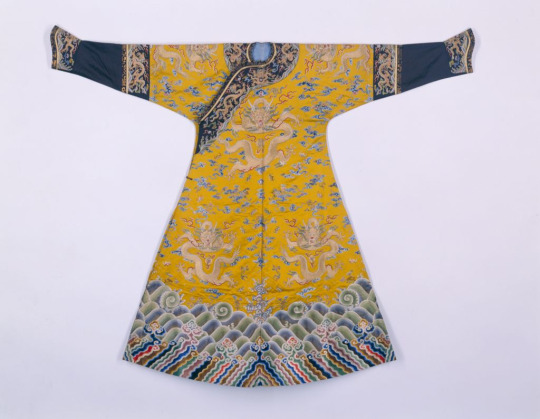
18th century jifu, a kind of court dress. Apart from the overrepresentation of court dress, Qing Dynasty garments are ALWAYS displayed in this manner (laid flat instead of draped on a mannequin, because that would be too humanizing) in photographs from books and articles for maximum orientalism (no concrete evidence, just how I see it). Not that there’s anything wrong with displaying garments like this, it’s probably the best way to store them, but the severe lack of visual representations of how 2D clothes look on 3D people is frustrating.
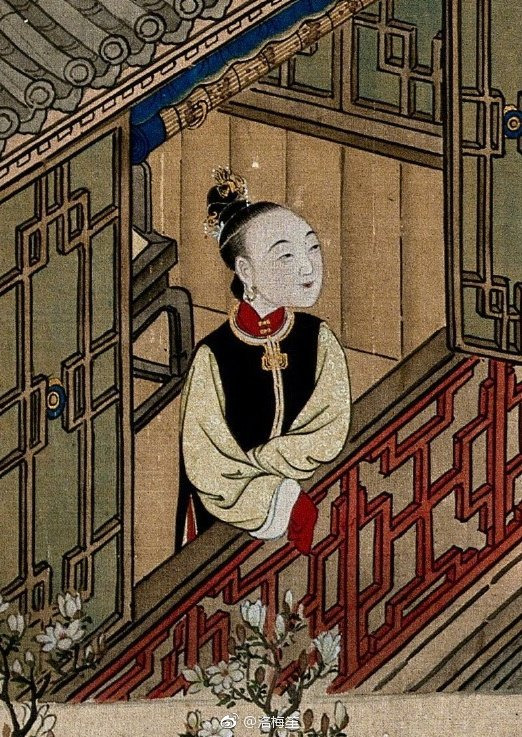
18th century civilian fashion in a painting.
Continuity and difference
Oftentimes Chinese historical fashion is treated as sporadic episodes, people dressing themselves in one style and then suddenly changing to another one overnight when a new dynasty/decade is established. This mindset probably won’t take you very far in fashion history, because historical Chinese fashion was more like a continuous stream of development where small changes happened one after another, adding up to a major change every now and then. Seeing history as clean cut episodes marginalizes transitional periods where either important changes happened or things were simply very interesting and worthwhile to study.
When put into a postcolonial context, however, the use of clean cut time periods suddenly appears somewhat helpful. Like I explained, there are problems with the episodic view of history, but you have to admit it’s useful for representation. When people think of Western historical fashion, most can name certain periods or styles like 18th century robes a la francaise, high waisted Regency gowns, Victorian crinolines and bustles etc., which one probably learns from period dramas and the like. Whether the impressions are accurate is beside the point, as firstly there is an awareness that there were distinct periods and styles. The same cannot be said for the general perception of historical Chinese fashion, or any other non white society’s historical fashion, even though it is entirely plausible and even easy to divide Chinese historical fashion into similar distinct periods with their unique characteristics. People just think of historical Chinese fashion as “Chinese”, as if that alone is an accurate or sufficient description. As of currently, the only periods and styles represented in this way are, I think, Tang Dynasty chest-high ruqun, Qing Dynasty Manchu court dress and maybe Republican era cheongsam, which are common subjects of representation (with miserable accuracy) in period dramas. I personally would suggest people first getting into Chinese fashion history to come up with some of these time period distinctions but not take them too seriously, as they’re good for understanding the general gist of a time period and invite further research.
Narratives
Now I would like to delve into more abstract and ideological territory.
Maybe the smart people reading this can tell me if this is postmodern or something, but I think it’s important to keep in mind that lived experiences of fashion in history often run contrary to grand narratives about fashion and society that attempt to sanction what they should look like and police the acceptable ways in which they are interpreted. There are especially many grand narratives and discourses around 19th and 20th century Chinese fashion, such as the classic colonial line about late Qing fashion being backwards and stagnant and needing Western intervention I berate every so often, the pseudo feminist line about Republican era women’s fashion being inherently liberating (I’m going to talk about this in more depth in another post I’m working on), and the Cold War era anti-communist misconception about Mao era PRC not having fashion etc.. Not to mention how many of these narratives were built upon ignorance of actual historical fashion, as fashion history did not become an established discipline until the 1970s and writers speculating before that usually misinterpreted facts or straight up fabricated them (I have a couple examples of this I’m thinking of posting later). These always make me so uncomfortable I feel like I couldn’t breathe, like they’re trying to force me to feel a particular way and put my brain into a very small and tight box.
This is because the 19th and 20th centuries were centuries of grand narratives, shaped by various phenomena and ideologies of the modern era like colonialism, nationalism, fascism and communism. These are essentialist narratives constructed by historians that often serve present and future socio-political purposes, and should be handled with suspicion. These narratives are so influential that they often lead people to carry out intricate mental gymnastics to deny reality; no number of genuine photographs, films and artworks can convince someone sold on grand narratives that many people did indeed wear nice clothes in Mao’s China, seriously I’ve tried and failed so many times. If a narrative is constantly proven wrong by pieces of evidence, maybe it’s time to ditch it.
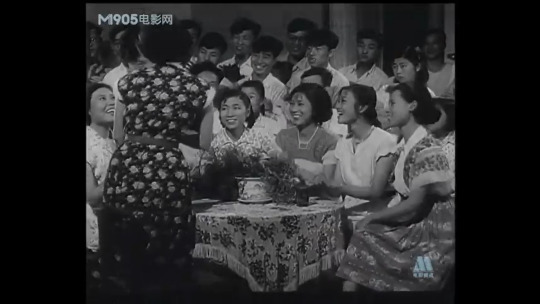
Costumes in 1950s mainland film.
Grand narratives existed before the 19th century too, I’m just not very well versed with them and can’t comment much, though I assume the general gist is the same. A well known example off the top of my head is the dynastic cycle theory in imperial era historiography, which describes Chinese history as cycles that repeat themselves with each dynasty. This view is allowed to fester in fashion history as well, with historians often describing fashion at the beginning of a dynasty as “simple” and “conservative”, which gradually develops into more extravagant and spectacular forms as the dynasty’s political power declines. An obvious problem with this view is its equating luxury and consumption with moral degeneracy and decline, which was historically used by Chinese ruling classes as a tool to enforce Confucian ideology. The other problem is that it completely fails to explain fashion at a more detailed level when it comes to actual, tangible features like fabrics, decorative motifs, silhouettes etc., and disregards linear, continuous changes that took place across dynasties. For example, late Ming women’s fashion showed more continuity with the early Qing than earlier parts of the same dynasty, and it’s more helpful to see the Ming and Qing as a continuum in terms of textile production technology and aesthetic tastes rather than two distinct cycles. (Come to think of it, I’m not sure whether dynastic cycle theory was actually used by Chinese historians before Western colonialism, or it was assumed that it was used by historians of the 20th century. That makes quite a difference.)
This is just one example, these grand narratives are everywhere and way too rampant in Chinese history discourse (not just fashion) to simply avoid or ignore. It would be more effective to have some knowledge in historiography (the study of the study of history) and theory so you can actively unravel and deconstruct them to ensure a smooth and pleasant journey on the highway of fashion history. Out of the books I’ve read so far, the ones that helped me the most are probably Edward Said’s Orientalism (I would be nowhere without him!), Judith Butler’s Gender Trouble and Frantz Fanon’s Black Skin, White Masks. These are very basic and accessible books so they’re useful outside fashion history as well.
To save you the trouble of feeling unnecessary ways like gasping in disbelief at the sight of beautiful dresses from the 1950s mainland, I suggest not to take grand narratives seriously, as they cause too many practical problems when you want to look at things a little deeper beyond surface level. I’m not asking for objectivity as it’s probably impossible, I’m not objective at all, I’m asking for an awareness of narratives and power dynamics. It’s better to first familiarize yourself with the factual part of fashion history i.e. what silhouettes and hairstyles were popular in what year/decade, before constructing narratives, or not construct narratives at all.
High expectations
Because of the prevalence of Eurocentrism and the massive volume of literature and media already produced about historical Western fashion, as well as the relatively recent academic interest in the historical fashion of non white societies, it can give people just starting out in Chinese fashion history the wrong idea that it’s going to be a breeze compared to the highly professional and demanding field that is Western fashion history. Please don’t get into Chinese fashion history expecting it to be easy. I’ve made this mistake in the past and paid a hefty price for it (significant loss of brain cells and hair trying to figure out stuff in an extremely niche subject and time period). Most people are probably aware that China had a fashion history, but most also aren’t aware of how complex and rich it actually is. You can really afford to be as specific and pedantic as you like, narrowing down changes in styles to those within a decade or between every 2 or 3 years as is customary for the 20th century. I’m not gatekeeping or trying to scare people off, if anything it’s good that Chinese fashion history is so complex because there’s always something new to learn. It’s just that I constantly get this vibe from some people in my askbox that they think Chinese society is so primitive and simple that I can answer some of their super generalized questions in one sentence or something. That’s really counterproductive.
TL;DR use primary sources, read recent literature, be wary of grand narratives, keep an open mind, apply the same theories and criticisms from other academic disciplines, and you should do just fine. And have fun exploring Chinese historical fashion!!
194 notes
·
View notes
Text
Maybe three weeks ago, I asked my wife if she'd mind if I took a corner of our bedroom and used it to hang up all my danmei blorbo posters and stuff I've accumulated as freebies when I've bought books (especially, the SVSSS vol 4 spec edition, the print editions of Golden Stage and Thousand Autumns in Chinese, and the TGCF art books and manhua). She gave her permission, and after going through the stash and hanging a few things a day as I've had the time, I'm finally done!
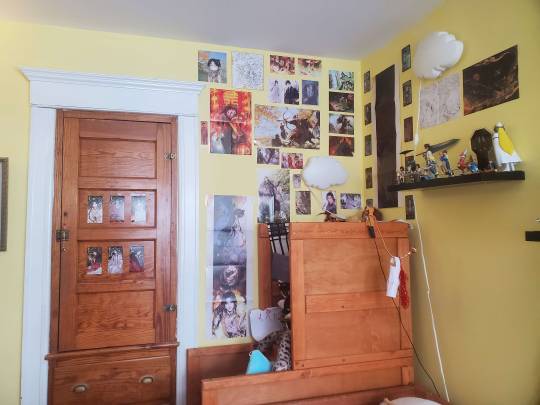



I'm doooone! I do have other posters but eh these are the ones I wanted to hang for now. I'm sure the stash will grow anyway. The posters got added to my figurines and dolls, which have been on display for a couple years. The oldest of these, I've had since the late 90s.
(if you read my long text post yesterday...hanging all this stuff up is part of why I was thinking back on how it felt to be 17-year-old me. Because like. I was so scared I'd have to change, be forced to conform, would look back on myself and go "damn she was cringe" but no, I don't at all, and I think past!me would think present me was pretty damn cool tbh. I'm openly queer and married to a neat geeky woman! I have cute kids! I own a home! I have cool hair and tattoos and piercings! I did so many of the things she was scared of yet wanted. It's nice to think I grew up into the kind of person I'd have thought was a cool grown up.)
Bonus: I thought I had a picture of my high school bedroom but I can't find it. But I did find a picture of my freshman college dorm room.

Age: 17. Year: 2000.
My blorbos were different but the gist hasn't changed at all.
Double Bonus:

These are the same doll, lmfao.
I really, really haven't changed. 😂
Behold the cringe, and despair. 😂😂😂😂😂
27 notes
·
View notes
Text
Wreath
Day 2 entry for @12daysofhatchetfield
“Gather around, everyone! Staff meeting!” Ken Davidson calls jovially, waiting for his four employees to gather outside of his office before continuing, “We’re going to start a new holiday tradition!”
Paul grimaces, but keeps quiet.
Oblivious to Paul’s discomfort, Mr. Davidson hangs a plain, green wreath on his office door. “I want you all to bring in something that makes you think of the holidays to decorate this wreath with.”
“Anything?” Ted asks with a wiggle of his eyebrows.
“As long as it’s appropriate for work,” Mr. Davidson clarifies.
Charlotte is the first to bring in something. The very next day, she has a large, handmade, glittering red and gold bow that she fastens to the wreath.
Later that same day, when no one is watching, Ted tenderly nestles a little polar bear plush clutching a Coca-Cola bottle amongst the greenery.
It takes Bill a few days to find his item, having to go through the decorations at home to find it. Finally, he finds a wooden bauble-shaped ornament that Alice decorated in elementary school, covered in pink paint and multi-colored glitter. He hangs it from the top of the wreath.
Surprised his employees got decorations up so quickly, Mr. Davidson quickly adds one of his garish holiday ties. Multi-colored light and baubles adorn the fabric.
“Oh, hey Melissa,” Paul calls one morning as she passes his desk.
“Hi Paul!” She turns to him, cradling a small cat figurine.
He notices it, chuckling slightly at the tiny Santa hat on the cat. “That your thing for the wreath?”
“Yep!” She finishes walking to Mr. Davidson’s door, carefully resting the cat on the inside curve of the wreath. “It looks like almost everyone has brought in something.” She looks back to Paul with an infectious grin. “Which is yours?”
“Oh. I, uh, haven’t yet.” He shrugs. “Haven’t found the right thing yet, y’know?”
She nods. “Well, I know Mr. Davidson wants everyone to bring in something by the office party. Good luck on your search!” She bids him before walking away again.
Shit. The Christmas party is in just a couple weeks. Paul frowns before going back to work to distract himself.
The deadline seems to loom over him. After work that day, he heads to one of the craft stores, hoping to find something to bring in.
The store is packed, full of shoppers taking advantage of the ridiculous sales going on. Paul sidesteps into an aisle to avoid getting hit by a cart. He glances around, eyebrows raising when he sees the different ornament hanging up. There’s all sorts, not just the classic bauble shape.
He spies a Chinese takeout ornament, but dismisses it. He scans the pegs, trying to decide on something. Finally, he spies a clear, to-go cup, decorated to look like it’s filled with black coffee. He smiles slightly at the sight, reaching out to pick it up.
He does love coffee, especially on a cold Christmas morning.
The next day, he adds his ornament. He takes a step back, admiring the finished project. Not that he’d ever admit it.
#12 days of hatchetfield#12doh#paul matthews#ken davidson#charlotte sweetly#bill woodward#ted spankoffski#melissa#ccrp gang
21 notes
·
View notes
Photo



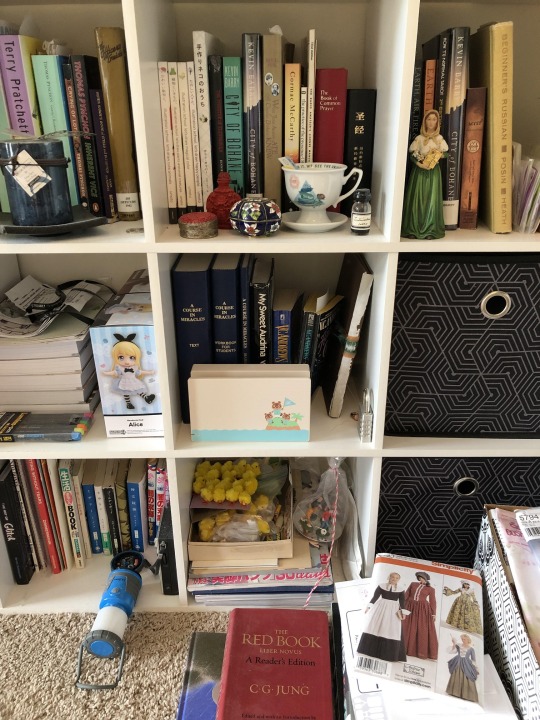

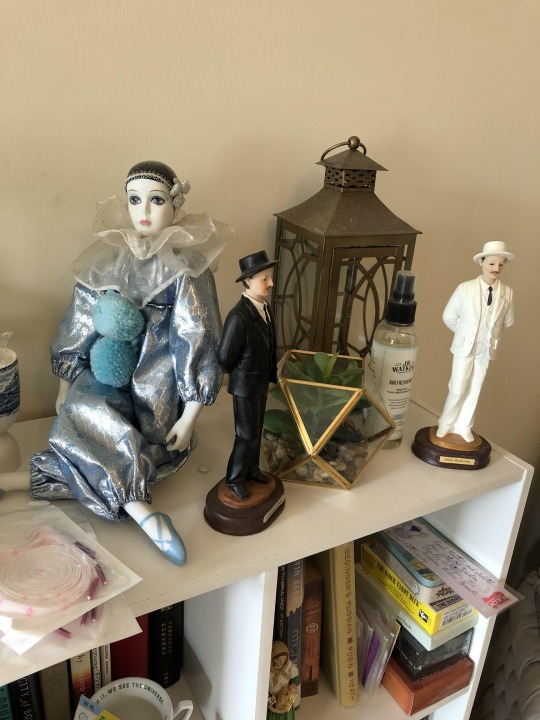
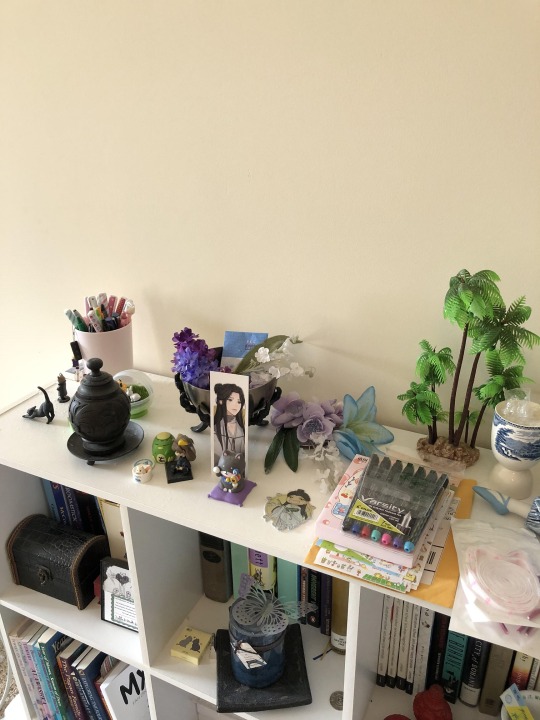
Haunted Doll Watch!! That’s Delaine in the striped chair (haunted doll 1) and the harlequin doll is Luna (haunted doll 2)
Books! Mostly witchcraft, Wicca, and New Age junk that I snagged for free out of a donation bin during my library days. Yes it includes Big Blue Buckland and To Ride a Silver Broomstick. You can’t see the nearly-complete Kyron collection behind the Pagan Family book but it’s there. Also yes that’s a fanbook for the MXTX series.
The Chris Chan art is on the top shelf next to the tiny treasure chest (which contains old, old Black Phoenix Alchemy Lab scents).
World Band radio from my dad. Journals and notebooks down there.
Literature shelf 1: Joyce and Pynchon and Pratchett but also a first edition of New Frontiers of the Mind which was about to get weeded at a library. Naturally I grabbed it. Also Sister Karol’s Little Book of Spells and Rituals which is so odd and I love it. Rando army officer’s guide that once belonged to a Rosicrucian. No joke.
Tasty-smelling unused candle (unused) with silver butterfly, Nendroid boxes, MXTX books lying down (because they tend to bend when standing up). Imported stickers.
Bottom shelf is a lot of foreign language: Japanese novels, including Memoirs of a Geisha, Misery by Stephen King, and one titled God Is a Gun. Again: donations that I grabbed. Couple of manga because back in the day you could score Japanese manga at conventions. I miss those days. It was fun. One book in Japanese about “Getting Along in English” and another on “adulting.” Also the Glitch game artbook. I miss Glitch so much. The lantern is disassembled because the batteries leaked and I need to clean it up, sigh.
Literature shelves 2+: drawing books, Japanese craft book for cat houses, Cormac McCarthy my beloved, The Practice of the Presence of God. BCP (baptism gift to me as a baby) and the Bible in Chinese (another donation). Teacup for gin (it’s the cucumber one, yes). Random bottles and jars because I love them. A Course in Miracles both volumes and teacher’s workbook (more donations). V.C. Andrews because I sometimes have no taste. Haunted photograph, Arthur, is in the ripped-up looking case to be protected from sunlight. Animal Crossing: New Horizons-edition Switch dock (I didn’t want the paint/decal to get scratched). Little tiny chenille chicks used for pranks. People in a bag for Sashimiko cosplays. Japanese fashion magazines and Gothic & Lolita Bibles. The Red Book sitting on a children’s book in Chinese, partial view of sewing patterns. Unseen: more books stacked on the floor.
Literature shelves 3+: with Saint Dymphna, patroness of those with mental illnesses. Listen, I’ll try anything. There’s Big Blue Buckland’s, couple more Llewellyn magic(k) books, the Normal Tarot book, and the third copy of City of Bohane (I love that book but not enough for 3 copies; long story). Tarot cards and Lenormande cards. Russian language book. Imported stickers. Random electronics bits (cords, &c) and office supplies live in the two bins.
On top you’ve got Senor Misterioso (he glows in the dark) and his real saint figurine self, Doctor Jose Gregorio Hernandez. They are counterparts. Lantern. Fake succulent. Rando room spray. SACRED TUMBLR BRAND SHOELACES!!!! Aforementioned haunted doll, Luna. Egg cup with blessed salt.
On the other side, egg cup w/ salt (alt. view), plastic palm trees from my old desk in the library, “fake” fountain pens and more imported stickers. Fake flowers mostly from cosplay, bowl held by claws (Target Halloween 5 or 6 years ago), cup with a jubilee of pens. Xie Lian bookmark 💗 Tiny gashapon and blind box doodads. Wooden jar.
There you go. That’s my shelves. I can entertain questions if you’d like. Closeups available.
15 notes
·
View notes
Photo
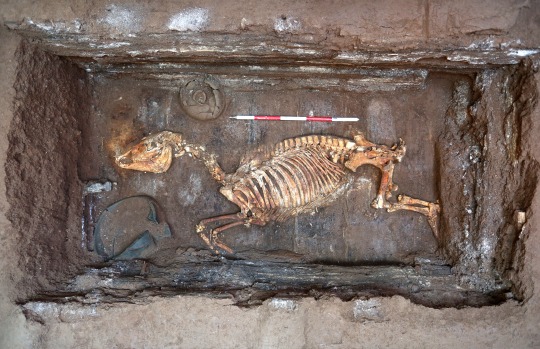
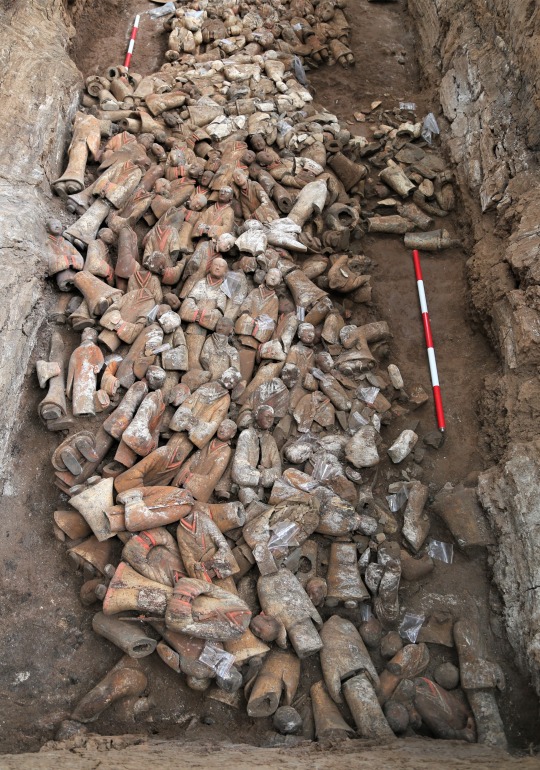
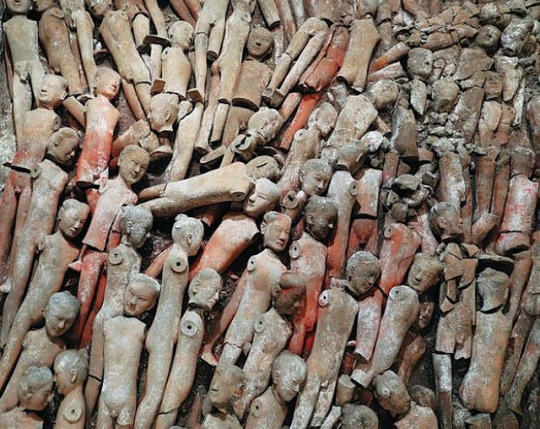


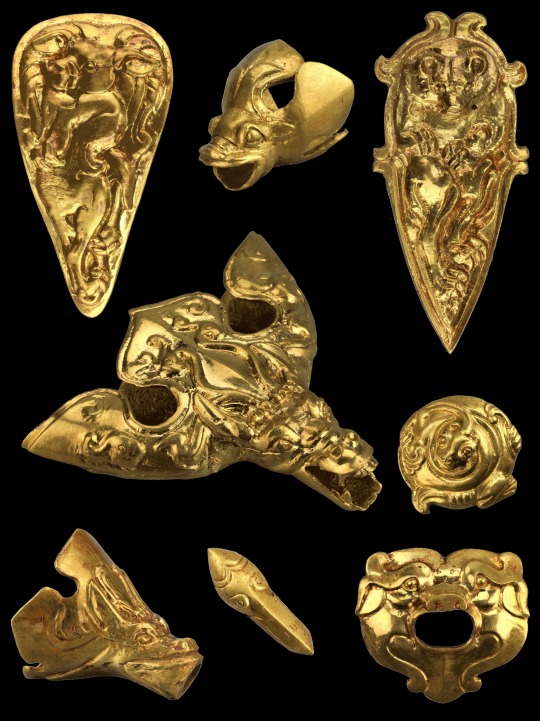
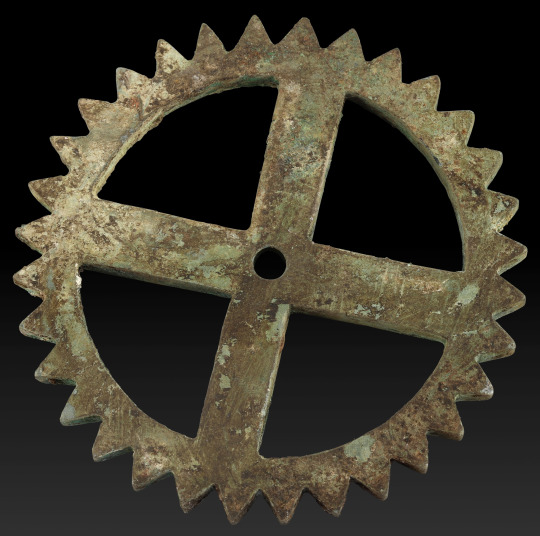
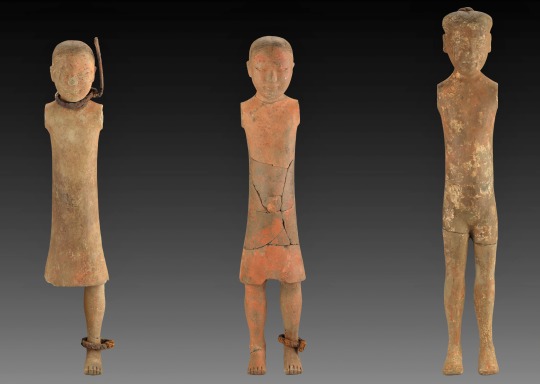
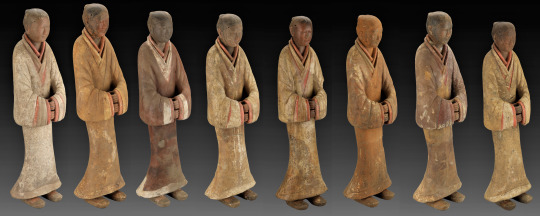

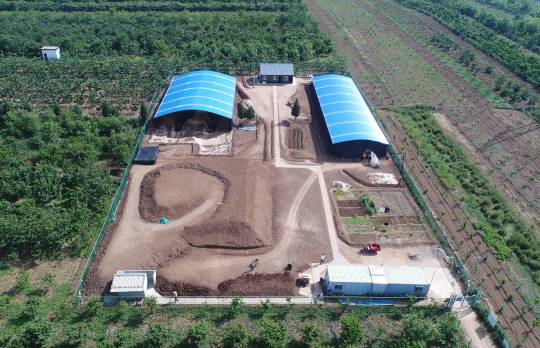
The 2,000-Year-Old Tomb of Emperor Wen of Han Discovered in China
After years of study, a more than 2,000-year-old grand tomb in Xi'an, the capital of Shaanxi province, was confirmed to be the mausoleum of a famous emperor of the Western Han Dynasty (206 BC-AD 24), the National Cultural Heritage Administration announced on Tuesday at a news conference in Beijing.
Liu Heng (203 to 157 BC), or Emperor Wen of Han, was the third emperor of the Western Han Dynasty. He was famed for diligence and thriftiness.
The reigns of Emperor Wen and his son Emperor Jing were hailed by historians as the Rule of Wen and Jing, the first period of general stability and prosperity during China's imperial years.
Ancient documents roughly indicated the location of Emperor Wen's mausoleum, known in history as Baling, but its specific whereabouts had remained obscure.
Also called the Jiangcun Grand Tomb, the newly confirmed mausoleum site was found in 2006. In 2016, some areas surrounding the site were raided by tomb robbers, and a rescue excavation was later launched by archaeologists.
Based on excavations at the tomb site since 2017, the structure and burial objects that were unearthed have revealed the extraordinary identity of who is buried there, according to Ma Yongying, a researcher with the Shaanxi Academy of Archaeology.
"Its format and large scale fit the highest-level tomb of the Western Han Dynasty," he said. "The idea is also supported by our investigations of the outer burial pits around the tomb."
More than 110 burial pits were scattered around the tomb. According to Ma, though only eight burial pits have been excavated, over 1,000 pottery figurines that "guarded" the emperor were found. Thousands more artifacts made of pottery, iron and bronze were also unearthed.
Some of the bronzeware pieces were decorations for horses and chariots, and a group of Western Han officials' seals were also among highlights of the discoveries.
"It showed these pits may mimic an entire system of government," Ma said. "The emperor wanted to rule his country even in the underworld."
Researchers once faced challenges in looking for Baling, because no towering mound was erected to seal Liu Heng's mausoleum due to the emperor's preference for a simple lifestyle.
Archaeological investigation in the area began in the 1960s. Preliminary excavations were also made in the 1980s and around 2000.
A site about 2 kilometers north of the Jiangcun tomb was previously thought to be Baling. However, follow-up research there was fruitless, prompting archaeologists to switch their focus to the current site.
Ma said that the discovery of the graves of Liu Heng's empress and his mother further indicated that the grand tomb in the center should be the emperor's long resting place.
"It is the earliest Western Han royal graveyard in which the emperor's tomb was put in the center and was surrounded by burial pits," he said.
The discovery of Baling also means that the whereabouts of all 11 Western Han emperors' mausoleums in or near Xi'an, then the national capital known as Chang'an, have been confirmed, Ma said.
The grand tomb was a milestone in the evolution of Chinese royal mausoleums, said Liu Qingzhu, an archaeology researcher with the Chinese Academy of Social Sciences.
The emphasis of previous rulers' mausoleums was more on connections within their own families. For example, royal couples were often buried together.
"But Liu Heng's tomb reflected that the country, represented by the emperor's power, was the priority," he said, adding that studies of the tomb also are a key to understanding the forming of China's national identity.
By Wang Kaihao.
#The 2000-Year-Old Tomb of Emperor Wen of Han Discovered in China#ancient grave#ancient tomb#ancient mausoleum#archeology#history#history news#ancient history#ancient civilizations#western han dynasty#The Rule of Wen and Jing#treasure#gold#bronze
90 notes
·
View notes
Text
About Morax’s many titles
There are still Genshin fans who think that Morax’s titles of “God of War”, "God of Commerce", "God of Justice”, etc., were just misinformation created by players...So here is part of Zhongli’s 3rd character story, from the game itself.


Now, when it comes to the Archons, they do have different titles based on their different ideals, but these titles of Morax/Zhongli were given to him by the people of Liyue. That doesn’t make them any less “canonical” than the titles of other Archons. In the fictional world of Teyvat, these titles are all canon.
Personally, I like this particular aspect of Liyue, since it is a nod to the diverse and sometimes confusing system of traditional Chinese beliefs. Much of Liyue’s background is based on Daoism, and much of Daoism is in turn based on folk beliefs, which accounts for some of the “disorganization”. Many Daoist deities were real historical figures who had lived in this world, and people deified certain aspects of them, thus elevating them to godhood (this works similar to canonization in Catholicism, with one of the biggest differences being there’s usually no religious authorities to approve of the process).
An example of this is Guanyu/关羽, who was a general of Shu during the Three Kingdoms period (220-280 AD). He is now revered as “God of Wealth”/财神 by many Chinese people (kind of like a “patron saint” of businesspeople). Even outside of China, sometimes you can find small figurines of him enshrined inside Chinese businesses.
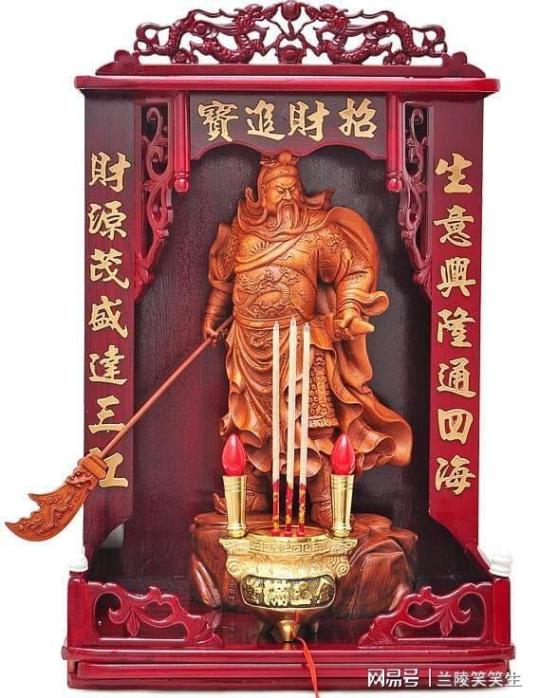
And here’s a large statue of Guanyu inside the Wuhou Shrine/武侯祠 in Chengdu, China, which I visited a couple years ago while on vacation (I didn’t take this picture though). Note that although his statue is depicted here as wearing royal garments, historically Guanyu was never an emperor. This depiction likely came from one of his titles given to him much later by admirers/worshippers: Guan Di/关帝, which best translates as “Guanyu the Sovereign”.

But here’s the mystery: if Guanyu was a general whose job was to defeat the opposing army in battle, why is he revered as “God of Wealth”? The answer to this lies in history. During Song dynasty (960-1279 AD; roughly one millenium after Guanyu died), one of the centers of salt production, Haizhou (解州; here “解” uses the archaic pronounciation of hai4), was affected by flooding caused by heavy rainstorms, and so the production of salt was impacted as well. This was a major problem back then, since historically, salt was a very valuable commodity. According to folklore, the emperor at the time then consulted the Daoist priest Zhang Daoling, who said the rainstorms were caused by the mythic entity Chiyou (蚩尤). Since Guanyu’s family hailed from this region, the Daoist priest called upon him to battle and subdue Chiyou, which solved the problem. (In reality, it was the government that paid workers to construct a dam to stop the flooding from destroying the salt ponds) As a result, salt production began again, and this in turn saved the local merchants who depended on this salt to make money. From that point forth, Guanyu started to gain followers as “God of Wealth”. People essentially took one aspect of Guanyu, namely that he was a general and a brave warrior, inserted him into a legend based on real events, and based on the outcome of the event, transformed him over time from a historical general into a deity of wealth and a patron god of businesses.
Genshin is different from real life in that in the world of Teyvat, gods really do exist, and actively shape the history of Teyvat. Therefore, the vast majority of the epic tales of the gods are true and did happen. But as with real life, the people of Liyue took different aspects and deeds of Morax and bestowed all these different titles upon him. And it’s not just the people of Liyue. Morax himself also created some of these legends, according to the ending of Rex Incognito. The focal point shouldn’t be the in-universe authenticity of these stories/titles, but what these stories/titles tell us about the storytellers. Aside from the more obvious titles of “God of Contracts” and “God of Commerce”, Morax became the “God of History” because the people of Liyue were proud of Liyue’s long history; Morax became the “God of the Stove” because the people of Liyue wished for a good quality of life; and Morax became the “Martial God”/”Warrior God”/”God of War” because the people of Liyue wished for a strong protector to preserve the peace and prosperity of Liyue. In Genshin and in real life, wishes for a better future was what gave rise to these adoring accounts of the past.
#genshin impact#liyue#zhongli#morax#chinese culture#chinese history#an explanation and exploration of morax's many titles
168 notes
·
View notes